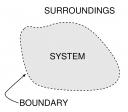 A key component to the second law of thermodynamics is entropy.
A key component to the second law of thermodynamics is entropy.
Entropy is the scientific principle that all systems will eventually go from order to disorder. Entropy allows mathematics to explain dissipation within a system boundary. In the first law of thermodynamics, energy is never lost in a macrosystem. But in a microsystem, entropy explains why stuff breaks down. The classic example of entropy is a glass of ice water. Water, a system where water is in a mixed state of solid and liquid, is constantly  breaking down. Entropy explains that eventually the glass of ice water will break down. The ice will melt into the water because of the heat energy outside of the glass or the liquid will freeze because of the lack of heat. But entropy will not allow the glass of ice water system to stay the same.
breaking down. Entropy explains that eventually the glass of ice water will break down. The ice will melt into the water because of the heat energy outside of the glass or the liquid will freeze because of the lack of heat. But entropy will not allow the glass of ice water system to stay the same.
In short, entropy is one of the variables that explains that stuff (a system) breaks over time. Pressure, stress, strain, temperature… all are variables. It’s why cars don’t last forever. It’s why toys eventually break. It’s why today’s superfast computer will be slow in three years. If you are a scientist designing a closed system… a car or a medicine or anything scientific you have to plan for entropy… that system will break down over time. If a scientist has no plan for entropy in his system he has failed on a professional level.
But what about entropy in social organizations? Does social entropy exist within systems?
Here is a truism. Every social organization will break down eventually. Eventually, they will go from order to disorder.
One day Google will no longer be the search engine of choice. One day the YMX forums will stop fostering community among youth workers. One day school systems will cease to exist. One day Congress will stop meeting. One day Coca-Cola will stop mixing sugar and water. One day I will not be a pastor at my church. These are all social organizations and one day they will fall apart. This isn’t fatalism, it is the fate of all social organizations. Social constructions are all finite.
Social system entropy: Any closed social system (company, municipality, government, non-profit) will go from order to disorder.
Here’s the point: Within many organizations there is no plan which allows social entropy. In fact, the plan for social entropy is often what distinguishes the separation between a good organization and a great organization. There is a tendency within a social organization to respond only to today’s pressing needs without thinking fully about the situation they are called to plan for. This creates an ideal environment for unchecked entropy. This “force” pushes a system to its breaking point.
 The result is that most social organizations swing wildly because they mismanaged the control of disorder.. and CHAOS enters the system. With no plan, an organizations pendulum will swing further and further in a direction until the social system can stand it no more… then the social organization brings about a change which swings the pendulum to the other extreme.
The result is that most social organizations swing wildly because they mismanaged the control of disorder.. and CHAOS enters the system. With no plan, an organizations pendulum will swing further and further in a direction until the social system can stand it no more… then the social organization brings about a change which swings the pendulum to the other extreme.
Examples:
- Our nation is experiencing a pendulum swing politically. The last two national elections… the right got pushed “righter.” Now the social system “broke” from the “very right” and the pendulum will swing to one of the three degrees of “left” currently on the ballot.
- At a church you see this all the time. A church will lose a very careful pastor and then attempt to replace him to hire a very visionary leader. Or a church will lose an old pastor and go after a young pastor. That creates a social chaos within the church. Those pendulums swing all the time.
- When a school in our district lost a principal who was very social and popular with students, staff, parents, and administrators… that person was replaced with someone who wasn’t very social. The pendulum swung. People are complaining.
- A team fires a coach who was demanding and hires a “players coach.” It doesn’t work so they hire a demanding coach. The pendulum swings wilding out of control.
These aren’t “wrong” pendulum swings. But they are signs that the organizations are good and not great. These are moves that demonstrate the organization is out of control.
Great organizations do not allow the pendulum to swing wildly. They keep the swings mild.
Great organizations recognize that their social system will eventually break down and plan accordingly.
Great organizations know that a great leader will eventually retire or move on or mess up or die while holding that seat… and act accordingly. The provide a succession plan that does not push against a system that works.
In other words, great organizations know that they cannot prevent social entropy from doing what social entropy does. And they create a plan to allow for changes. Some social organizations who plan for an allow for entropy within their closed systems will naturally last longer than systems who do not allow for and plan for systems to break down.
Question: What are some ways social organizations can prevent entropy from preventing a good organization from becoming a great one?
Disclaimer for my scientific friends: I know I am using a physical science term for a social science question. I am certain that within sociology there is a term for this, but I wanted to engage this from a physical science frame of reference.
Leave a Reply